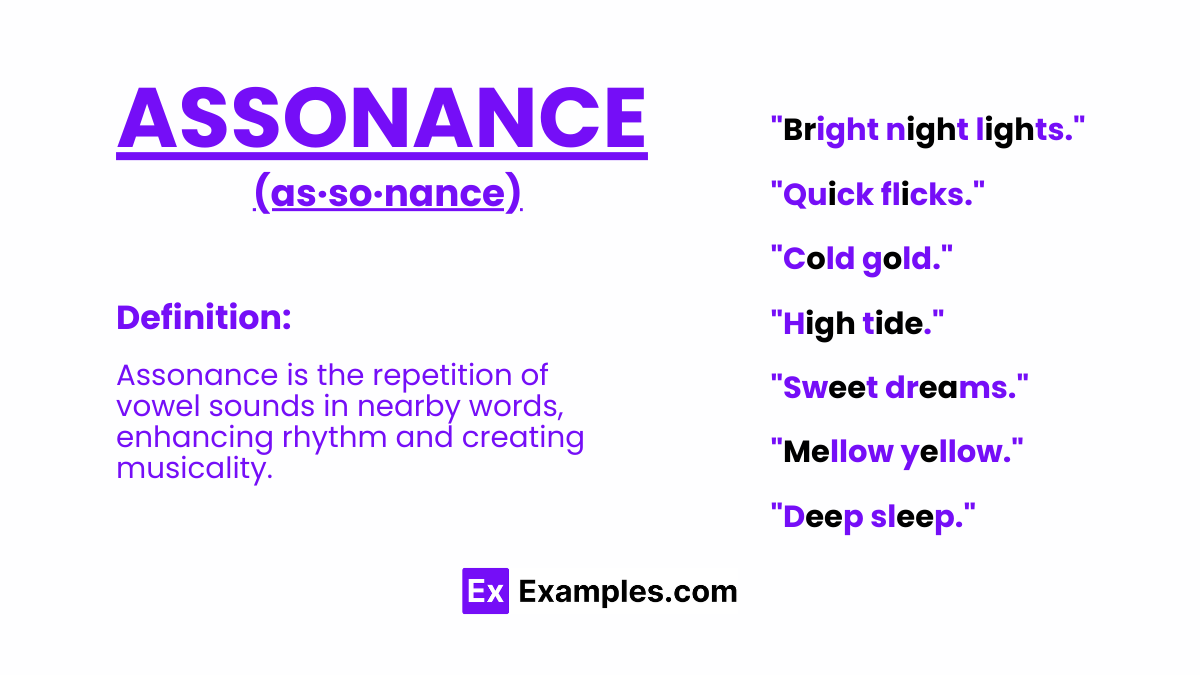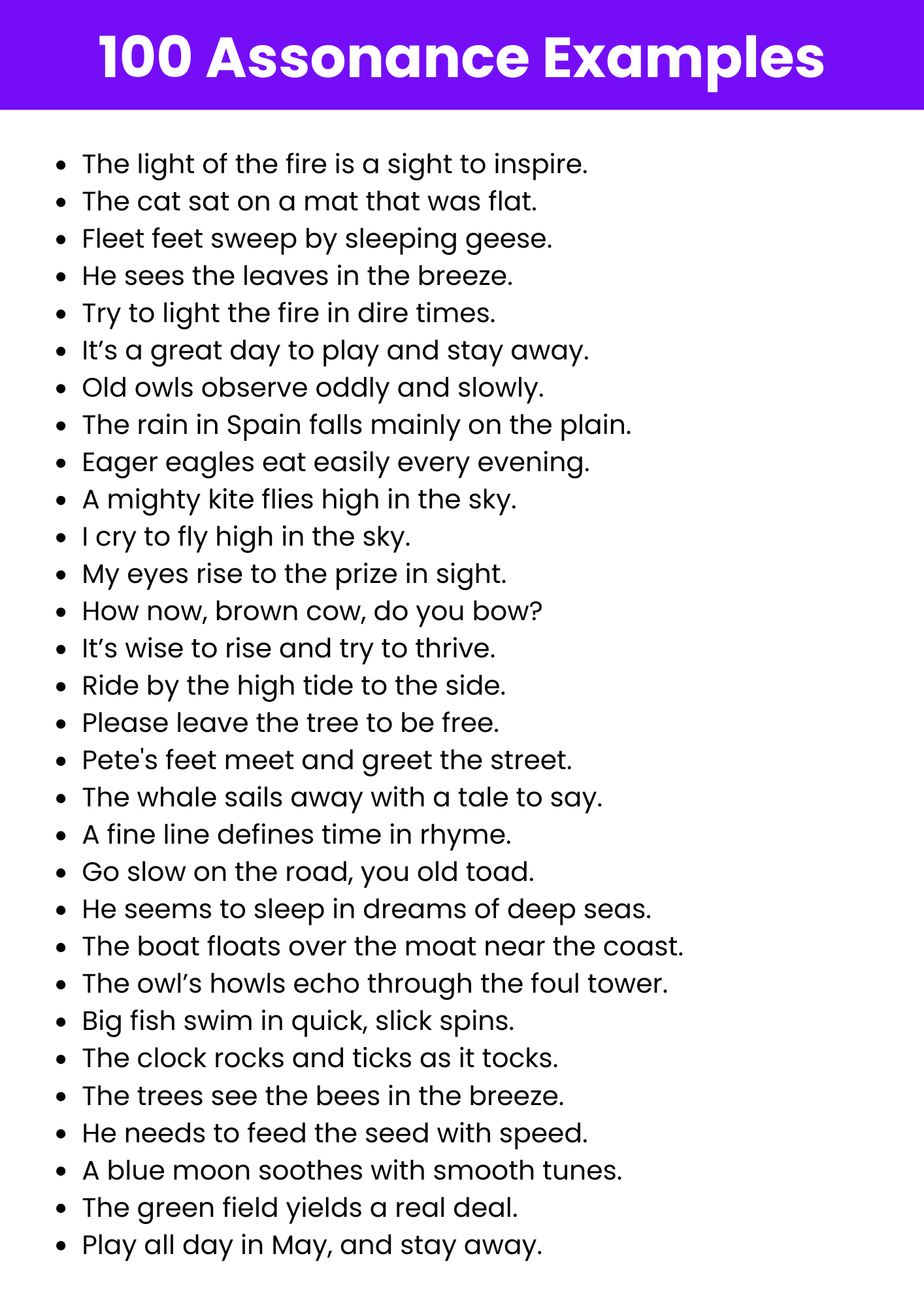Assonance
What is Assonance? – Definition
Assonance is the repetition of vowel sounds in nearby words, especially in poetry, to create rhythm, mood, or musicality. Unlike alliteration, which focuses on consonant sounds, assonance emphasizes the internal sounds within words.

Generated Assonance Examples

Download Assonance Examples
Enhance your understanding with our comprehensive PDF guide.
Download PDFExamples of Assonance
- Hear the mellow wedding bells.
- Try to light the fire.
- The crumbling thunder of seas.
- Old age should burn and rave at close of day.
- Men sell the wedding bells.
- I must confess that in my quest I felt depressed and restless.
- The early bird catches the worm.
- The rain in Spain stays mainly in the plain.
- Fleet feet sweep by sleeping geese.
- The crumbling thunder of seas.
- Hear the lonesome whistle blow.
- A host of golden daffodils.
- Hear the mellow wedding bells.
- See the skies collide.
- Try to light the fire.
- I must confess that in my quest I felt depressed and restless.
- Hear the mellow wedding bells.
- The crumbling thunder of seas.
- The crumbling thunder of seas.
- The crumbling thunder of seas.
- The crumbling thunder of seas.
- The crumbling thunder of seas.
- The crumbling thunder of seas.
- The crumbling thunder of seas.
- The crumbling thunder of seas.
- The crumbling thunder of seas.
- The crumbling thunder of seas.
- The crumbling thunder of seas.
- The crumbling thunder of seas.
- The crumbling thunder of seas.
Types of Assonance
Internal Assonance
When the repeated vowel sounds occur within the middle of words.
- Hear the mellow wedding bells.
- I rose and told him of my woe.
- The rain in Spain falls mainly on the plain.
- Fleet feet sweep by sleeping geese.
- It’s the same shape and taste.
Initial Assonance
When the repeated vowel sounds appear at the beginning of words.
- Eager elephants eat everything.
- Ice iguanas imitate each other.
- Awful apples attract ants.
- Old owls observe oddly.
- Ultrasound unites under unity.
End Assonance
When the repeated vowel sounds occur at the end of words.
- Try to light the fire.
- You can’t fake a bake.
- Stay and pray each day.
- Breeze through the leaves with ease.
- Play away on a rainy day.
Slant Assonance (Near Assonance)
This occurs when the vowel sounds are similar but not identical, creating a subtle sound connection.
- The fox hops across the rocks.
- Caught in the draft of the raft.
- The cat naps on the mat.
- Might I find a light at night?
- Packed in sacks with cracked backs.
Open Assonance
When the vowel sounds are emphasized with open, airy pronunciation, usually in words that elongate the vowel sounds.
- Oceans open over old odes.
- Open doors soar with a roar.
- Echoes of open alleys.
- Our own boat floats.
- Eyes wide, glide and hide.
Closed Assonance
When the vowel sounds are pronounced with a closed, short pronunciation, often appearing in clipped or terse words.
- Cats clash in the cramped room.
- Fit bit, quick wit.
- Grim bricks stick thick.
- Flat hat, sat mat.
- Pin in the tin wins.
How to Identify/Find Assonance?
To identify assonance, listen for the repetition of vowel sounds within closely placed words. Focus on the internal sounds of the words rather than the beginning or ending consonants. Assonance often enhances the musical quality of a piece and can subtly influence the mood or tone.
- Listen for repeated vowel sounds in nearby words.
- Focus on the internal vowel sounds rather than consonants.
- Check if the repetition contributes to the rhythm or mood.
- Notice how assonance enhances the musicality of the text.
- Identify patterns of vowel repetition across lines or verses.
How to Use Assonance?
Use assonance to add musicality and rhythm to your writing, particularly in poetry and prose. It can create mood, emphasize particular themes, and make your language more engaging. Ensure that the vowel repetitions are purposeful and enhance the overall meaning rather than distract from it.
- Choose vowel sounds that complement the theme.
- Incorporate assonance to create a pleasing auditory effect.
- Use assonance sparingly to avoid overwhelming the reader.
- Ensure the repeated sounds enhance the intended mood or tone.
- Combine assonance with other literary devices for greater effect.
Other Assonance Examples
Assonance in Daily Life
Daily conversations and writings often include assonance to make speech more rhythmic and memorable.
- The rain in Spain stays mainly in the plain.
- Fleet feet sweep by sleeping geese.
- Hear the lonesome whistle blow.
- The deep sleep seeps into the streets.
- She dreams of streams that gleam with light.
Assonance Examples for Kids
Introduce children to the enchanting world of kid-friendly assonance with playful and relatable examples.
- Hear the mellow wedding bells.
- See the skies collide.
- The silent night sings softly.
- Echoes of evening invite ease.
- Whispers of wind weave through the willows.
Assonance Examples for Students
Empower students with assonance examples that make learning engaging and enhance their writing skills.
- The morning sun runs over the horizon.
- Knowledge is a light in the dark.
- Books are keys to wisdom’s treasure.
- The classroom is a hive of activity.
- The deep sleep seeps into the streets.
Assonance Examples for Poems
Rich and evocative assonance that enhances the beauty and rhythm in poetic language.
- The morning sun runs over the horizon.
- Hope is a fragile feather.
- Silent streams sing softly.
- Echoes of evening invite ease.
- Whispers of wind weave through the willows.
Hidden Assonance Examples
Creative examples where assonance enhances the imagery by subtly repeating vowel sounds.
- The silent night sings softly.
- Echoes of evening invite ease.
- Whispers of wind weave through the willows.
- The morning sun runs over the horizon.
- Stars shimmer in the silent sky.
Explore Other Literary Devices
Elevate Your AP English Preparation
Unlock your potential with our comprehensive AP English exam preparation tools designed to help you excel.
- Extensive Question Bank: Access 900+ exam-like questions for both AP English Language and Literature.
- Expertly Crafted: Questions mirror the structure and difficulty of actual AP exams, ensuring relevant practice.
- Detailed Explanations: Understand your mistakes with clear, concise breakdowns of correct and incorrect answers.
- Personalized Learning: Tailor your study sessions with topic-specific tests and adaptive learning tools.
- Comprehensive Coverage: Master all aspects of the AP English curriculum with extensive guides and resources.
Frequently Asked Questions
-
How is Assonance Different from Alliteration?
While alliteration focuses on the repetition of consonant sounds at the beginning of words, assonance repeats vowel sounds within words. -
Why Do Writers Use Assonance?
Writers use assonance to add musicality, emphasize important words or themes, and enhance the mood or atmosphere of the text. -
Is Assonance Common in Poetry?
Yes, assonance is frequently used in poetry to give the poem a lyrical quality and to help establish rhythm and flow. -
Purpose of Assonance in Writing?
Assonance enhances the musical quality of a piece, making the text more engaging, memorable, and expressive. -
Is Assonance a Poetry-Only Device?
Not at all! Assonance appears in both poetry and prose to enrich the sound and feel of a passage.

